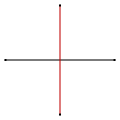| Regular digon | |
|---|---|
 On a circle, a digon is a tessellation with two antipodal points, and two 180° arc edges. | |
| Type | Regular polygon |
| Edges and vertices | 2 |
| Schläfli symbol | {2} |
| Coxeter–Dynkin diagrams | |
| Symmetry group | D2, [2], (*2•) |
| Internal angle (degrees) | 0° (convex) |
| Dual polygon | Self-dual |
In geometry, a bigon, [1] digon, or a 2-gon, is a polygon with two sides (edges) and two vertices. Its construction is degenerate in a Euclidean plane because either the two sides would coincide or one or both would have to be curved; however, it can be easily visualised in elliptic space. It may also be viewed as a representation of a graph with two vertices, see "Generalized polygon".
Contents
- In different fields
- In Euclidean geometry
- In elementary polyhedra
- As a spherical lune
- In topological structures
- See also
- References
- Citations
- Bibliography
- External links
A regular digon has both angles equal and both sides equal and is represented by Schläfli symbol {2}. It may be constructed on a sphere as a pair of 180 degree arcs connecting antipodal points, when it forms a lune.
The digon is the simplest abstract polytope of rank 2.
A truncated digon, t{2} is a square, {4}. An alternated digon, h{2} is a monogon, {1}.





